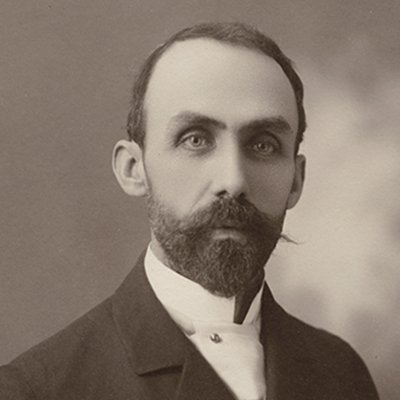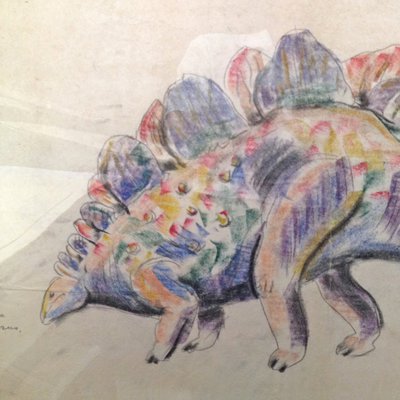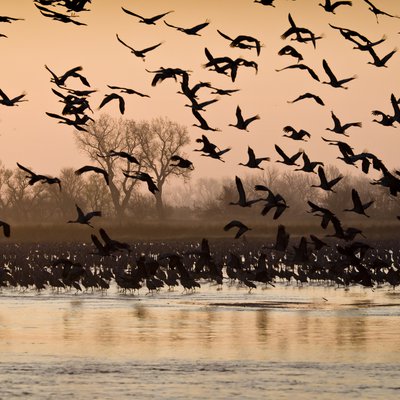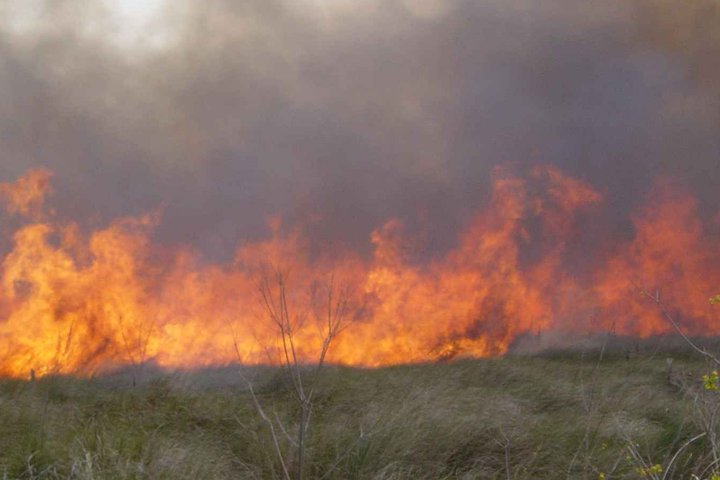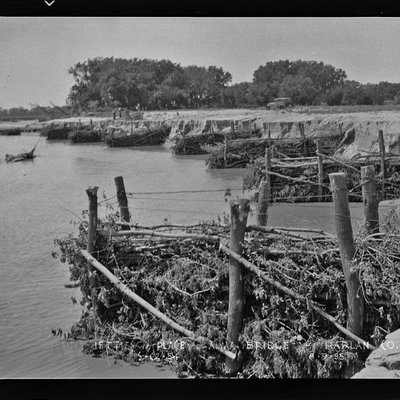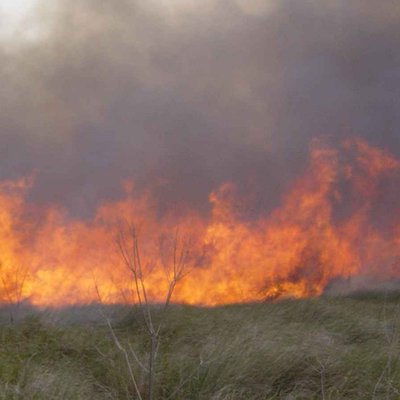CH 8
Rotunda
Nebraska's Resources
Lesson 1 - Earth, Air, Fire and Water
The floor mosaics in the Rotunda are all about creative energies. Mother Earth is right in the center of it. "Earth as the Life-giver," they call this one. The lady on the throne is based on the Roman goddess Ceres, and she's a symbol of the productivity of earth and soil. The person handing Ceres a bundle of wheat is Commerce, and the one with the urn of water is Industry. The one on the steps is Opportunity, right beside a basket of fruit. The sun is all around them. That’s how important Mother Earth is to everything—just ask her!
The large round central floor mosaic of the Earth Mother in the Rotunda floor has over 25,000 pieces of hand cut Italian and Belgian marble.

The floor mosaics in the Rotunda are all about creative energies. Mother Earth is right in the center of it. "Earth as the Life-giver," they call this one. The lady on the throne is based on the Roman goddess Ceres, and she's a symbol of the productivity of earth and soil. The person handing Ceres a bundle of wheat is Commerce, and the one with the urn of water is Industry. The one on the steps is Opportunity, right beside a basket of fruit. The sun is all around them. That’s how important Mother Earth is to everything—just ask her!
The large round central floor mosaic of the Earth Mother in the Rotundabuilding or hall topped with a dome floor has over 25,000 pieces of hand cut Italian and Belgian marble. (Reset image)
Spirits of Water, Fire, Air, and Earth

Looking beyond the sun, you see four other mosaics. These four depict spirits of Water, Fire, Air, and Earth, which were once called the four elements. Weaving around each of these central images you see the ancient life forms that are associated with each element. Reptiles can be found near Fire. Fish are found with Water, birds are with Air, and mammals are with Earth. Hildreth Meiere, the artist who designed these mosaics, used sketches drawn by a paleontologist along with a great deal of her own creative energy to come up with designs that bring together imaginary spirits and real creatures.
Hartley Burr Alexander, who chose the symbolic themes for the Capitol, wanted the RotundaBuilding or hall topped with a dome. floor to represent Ancient Earth, the foundation of life in Nebraska.
The creatures you see around Earth, Air, Fire, and Water are from geologic history, and include some found in Nebraska:
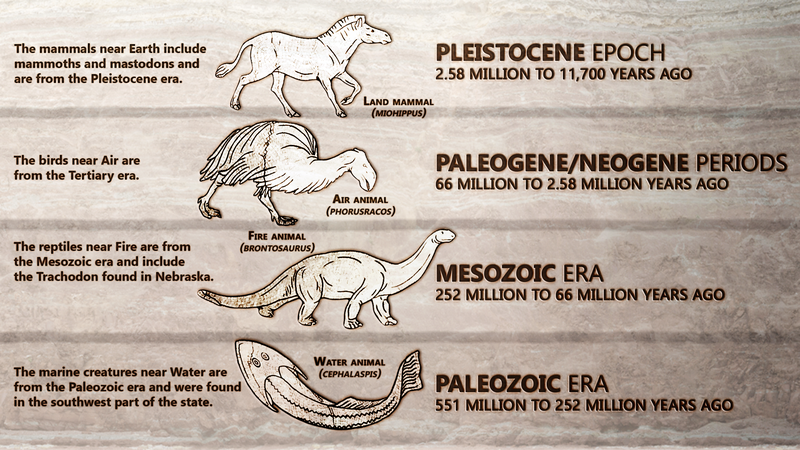
Earth, air, fire, and water have been pretty creative forces here in Nebraska.

Earth has made Nebraska what it is today. Glaciers left behind a material called till that combined with wind blown dust called loess to make Nebraska earth good for farming in the east. Nebraska's other forms of earth have been shaped by air and made useful by water for farming as well as grazing. But there are mineral resources, too. People mine sand and gravel along the Platte River and the Republican River, and they work limestone quarries near the Missouri River. You also find sandstone, clay, and shale. There's even a little bit of uranium in northwest Nebraska. (Reset image)
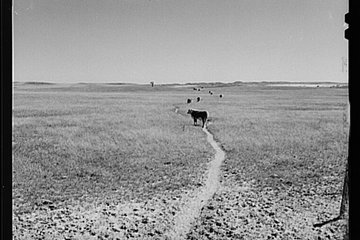
Air-- in the form of wind-- erodedTo erode is to wear away. sandstone and blew it into Nebraska to create a unique landscape known as Nebraska's Sandhills. Wind shaped the sand into hills and ridges, and grasses grew over it and held the dunesA dune is a hill of loose sand. in place. And those grasslands became a great place to raise cattle.
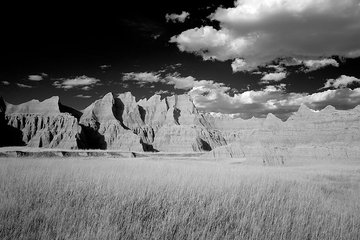
Wind blew a certain kind of siltTiny bits of rock and soil carried by water. into the state to create the flat LoessTopsoil. Plains in south-central Nebraska and the rolling Loess Hills north of the Platte River, also good farmlands. And in the northwest you find the High Plains, where you find a patch of the Badlands-- bare sandstone and siltstone hills carved by wind and other types of erosion.
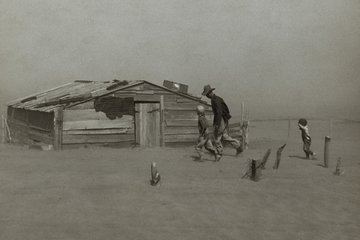
During the droughtAbnormal lack of rain or a long period of dry weather. of the early 1930's, wind blew away the topsoil and created blinding dust storms that left homes coated with dust, inside and out. Wind can turn deadly when tornadoes form. For example, in 1980, Grand Island, Nebraska was devastated by seven different tornadoes coming from several different directions.
Water has been a powerful force, too. The Platte River drew hunters, villages, explorers and settlers to its side, guiding and sometimes transporting them across the state. The lakes and wetlands in south-central Nebraska formed what is called the Rainwater Basin, very good for farming -- and very attractive to migratory birds such as the Sandhills Crane.
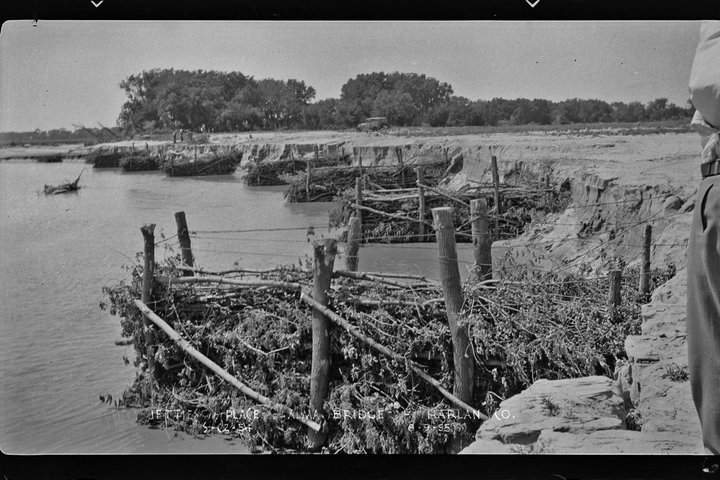
Lack of water, in times of drought, can affect fish and wildlife, increase the danger of fire, cause disease in trees, and lead to insect problems. But the Great Flood of 1935 came in the middle of a terrible drought. Both the Republican River and the South Platte flooded as a result of heavy rains in eastern Colorado.
Lack of water, in times of drought, can affect fish and wildlife, increase the danger of fire, cause disease in trees, and lead to insect problems. But the Great Flood of 1935 came in the middle of a terrible drought. Both the Republican River and the South Platte flooded as a result of heavy rains in eastern Colorado.
Fire has shaped life on the prairie. Long before humans tried to live here, prairie fires were part of the natural cycle, clearing the land for new growth. For early settlers, prairie fires could be disastrous, destroying homes and crops.
"Beautiful Nebraska,"
written by Jim Fras who came to Nebraska from Russia in 1952.
The song was chosen to be the official Nebraska state song in 1967
Download Sheet music for Beautiful Nebraska
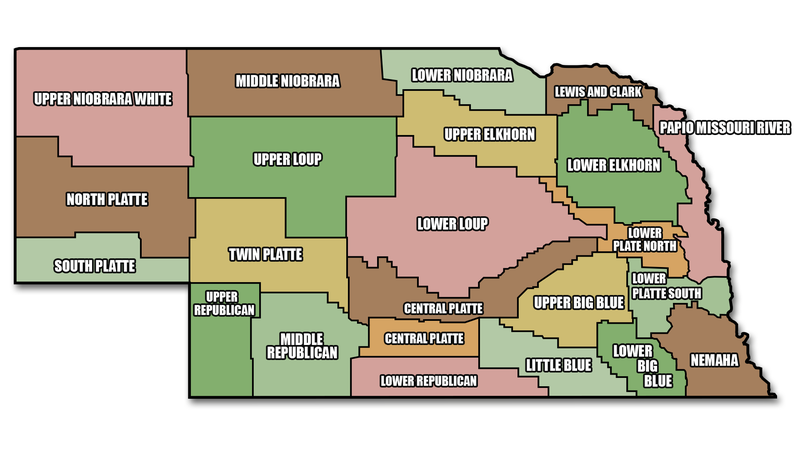
Nebraska has unique natural resources, and it created a unique way to take care of them called Natural Resources Districts or the NRD. The NRD is responsible for conserving and protecting soil and water. They handle problems with contamination, shortages, and disagreements among users. They also store information on natural resources.
The districts were created by the Nebraska Legislature in 1969. This system of caring for natural resources has become a model for other states, and helps Nebraska conserve and preserve what it has for generations to come.
SOMETHING TO THINK ABOUT . . .
Can you name times when the needs of people and the needs of nature are in conflict with each other?
How does government help take care of the needs of people and the needs of nature
. . . in the city?
. . . in the country?
